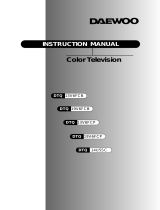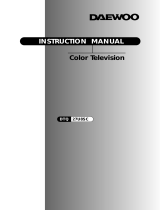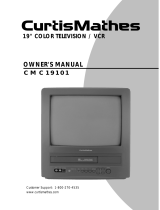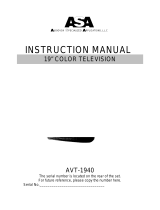
DTQ 14V1FCN
DTQ 20V1FCN
DTQ 14V4SCN
DTQ 20V4SCN
P/N:48586001E217-R0

The lightning flash with arrowhead symbol, within an equilateral triangle, is intended to alert the user to
the presence of uninsulated dangerous voltage within the product s enclosure that may be of suffi-
cient magnitude to constitute a risk electric shock.
The exclamation point within an equilateral triangle is intended to alert the user to the presence of
important operating and servicing instructions in the literature accompanying the appliance.
TO PREVENT FIRE OR SHOCK HAZARD, DO NOT EXPOSE THIS APPLIANCE TO RAIN OR MOISTURE.
CHANGES OR MODIFICATIONS NOT EXPRESSLY APPROVED BY THE MANUFACTURER COULD VOID THE USER S
AUTHORITY TO OPERATE THE EQUIPMENT.
THIS REMINDER IS PROVIDED TO CALL THE CATV SYSTEM INSTALLER'S ATTENTION TO ARTICLE 820-40 OF THE
NEC THAT PROVIDES GUIDELINES FOR PROPER GROUNDING AND, IN PARTICULAR, SPECIFIES THAT THE CABLE
GROUND SHALL BE CONNECTED TO THE GROUNDING SYSTEM OF THE BUILDING, AS CLOSE TO THE POINT OF
CABLE ENTRY AS PRACTICAL.
To provide power to the TV, insert the AC plug into a standard 120V~ 60Hz polarized outlet.
If you feel a static discharge when touching the unit, and the unit does not function, simply unplug the unit from the outlet. When you plug the
unit back in, it should work normally.
Do not install power cords near any heating element or cooking appliances.

CONTENTS
1
Your TV's Front Panel 4
Your TV's Back Panel
5
Your Remote Controls 6
Installing your remote control batteries
7
Notes 7
Connecting an Antenna 8
Connecting a Cable System 9
Connecting Other Pieces of Equipment
10
Safety Note 10
Turning your TV On 11
Programming Your TV's Channel Memory 11
Changing Channels
12
Changing the Volume 12
Changing The TV's Channel Memory
13
Adding/Deleting a channel to memory 13
Displaying the Current Channel
13
Changing the TV s Input 14
Adjusting Video Settings
15
Returning to the factory settings 16
Descriptions of video settings
16
Setting the Clock 17
Setting the Wake-Up Time
17
Setting the Off Time
18
Canceling the Wake-Up Time or Off Time 18
Setting the Sleep Timer
19
Changing the Language of the On-Screen Menus 20
Captioning
20
CC on Mute 21
Power Restore
21
Parental Control Settings 22
Description of Parental Control Settings
23

2
SAFETY
PLEASE READ ALL THESE INSTRUCTIONS REGARDING YOUR TELEVISION EQUIPMENT AND RETAIN
FOR FUTURE REFERENCE. FOLLOW ALL WARNINGS AND INSTRUCTIONS MARKED ON THE TV
RECEIVER.
Read all of these instructions.
Save these instructions for later use.
Unplug this television equipment from the wall outlet
before cleaning. Do not use liquid cleaners or aerosol
cleaners. Use a damp cloth for cleaning.
Do not use attachments not recommended by the televi-
sion equipment manufacturer as they may result in the risk
of fire, electric shock or other personal injury.
Do not use this television equipment near water, for exam-
ple, near a bathtub, washbowl, kitchen sink, or laundry
tub, in a wet basement, or near a swimming pool, or the
like.
Do not place this television equipment on an unstable cart,
stand, or table. The television equipment may fall, causing
serious injury to a child or adult, and serious damage to the
equipment. Use only with a cart or stand recommended
by the manufacturer, or sold with the television equip-
ment. Wall or shelf mounting should follow the manufac-
turer's instructions, and should use a mounting kit
approved by the manufacturer.
An appliance and cart combination should be moved with
care. Quick stops, excessive force, and uneven surfaces
may cause the appliance and cart combination to overturn.
Slots and openings in the cabinet and the back or bottom
are provided for ventilation and to ensure reliable opera-
tion of the television equipment; and to protect it from
overheating, these opening, must not be blocked or cov-
ered. The opening should never be blocked by placing the
television equipment on a bed, sofa, rug, or other similar
surface. (This equipment should never be placed near or
over a radiator or heat register.) This television equipment
should not be placed in a built-in installation such as a
bookcase unless proper ventilation is provided.
This television equipment should be operated only from
the type of power source indicated on the marking label. If
you are not sure of the type of power supplied to your
home, consult your television dealer or local power com-
pany.
In case of polarized alternating currency line plug (a plug
having one blade wider than the other). This plug will fit
into the power outlet only one way. This is a safety feature.
If you are unable to insert the plug fully into the outlet, try
reversing the plug. If the plug should still fail to fit, contact
your electrician to replace your obsolete outlet. Do not
defeat the safety purpose of the polarized plug.
Do not allow anything to rest on the power cord. Do not
locate this television equipment where the cord will be
abused by persons walking on it.
Follow all warnings and instructions marked on the televi-
sion equipment.
For added protection for this television equipment during a
lightning storm, or when it is left unattended and unused
for long periods of time, unplug it from the wall outlet and
disconnect the antenna or cable system. This will prevent
damage to the equipment due to lightning and power-line
surges.

3
An outside antenna system should not be located in the
vicinity of overhead power lines or other electric light or
power circuits, or where it can fall into such power lines or
circuits. When installing an outside antenna system,
extreme care should be taken to keep from touching such
power lines or circuits as contact with them might be fatal.
Do not overload wall outlets and extension cords as this
can result in fire or electric shock.
Never push objects of any kind into this television equip-
ment through openings as they may touch dangerous volt-
age points or short-out parts that could result in a fire or
electric shock. Never spill liquid of any kind on the televi-
sion equipment.
Do not attempt to service this television equipment your-
self as opening or removing covers may expose you to
dangerous voltage or other hazards. Refer all servicing to
qualified service personnel.
Unplug this television equipment from the wall outlet and
refer servicing to qualified service personnel under the fol-
lowing conditions:
(a) When the power-supply cord or plug is damaged or
frayed.
(b) If liquid has been spilled, or objects have fallen into the
television equipment.
(c) If the television equipment has been exposed to rain or
water.
(d) If the television equipment does not operate normally by
following the operating instructions. Adjust only those
controls that are covered by the operating instructions as
an improper adjustment of other controls may result in
damage and will often require extensive work by a quali-
fied technician to restore the TV receiver to its normal
operation.
(e) If the television equipment has been dropped or the
cabinet has been damaged.
(f) When the television equipment exhibits a distinct
change in performance - this indicates a need for ser-
vice.
When replacement parts are required, be sure the service
technician has used replacement parts specified by the
manufacturer that have the same characteristics as the
original part. Unauthorized substitutions may result in fire,
electric shock or other hazards.
Upon completion of any service or repairs to this televi-
sion equipment, ask the service technician to perform safe-
ty checks to determine that the television is in a safe oper-
ating condition.
If an outside antenna or cable system is connected to the
television receiver, be sure the antenna or cable system is
grounded so as to provided some protection against volt-
age surges and built-up static charges.

4
Overview of Your Equipment
CHAPTER
1
Your TV comes with a remote control. The section below summarizes the buttons, controls, and terminals that you
will use with your TV.
Use this button to turn your TV on or off.
Use these buttons to change channels on your TV, or to select items in the menu system.
Use these buttons to change your TV's volume, to activate selections in the menu system, or to change audio
and video settings.
Use this button to turn the TV's menu system on and off.
This indicator lights up when the power is off.
This receiver receives a signal from your remote control. Do not block it.
Use this jack to receive a video signal from another A/V component.
Use this jack to receive an audio signal from another A/V component.
Use this jack to receive an audio signal from your TV.
12 34567 8 9
STAND-BY
POWER
CH VOL
MENU
VIDEO AUDIO
EARPHONE

Use this terminal to attach an antenna or cable system to your TV.
This terminal allows the TV to receive a video signal from another component, such as a VCR.
This terminal allows the TV to receive an audio sighal from another component, such as a
VCR.
1
2 3
ANT
VIDEO AUDIO
5
Overview of Your Equipment

6
Overview of Your Equipment
4
1
8
7
11
3
9
10
2
6
3
4
5
4
1
8
7
11
3
9
10
2
6
3
4
5
Use this button to turn your TV on or off.
Use to turn the TV s sound on and off.
Use these buttons to change channels on your TV, or select items in the
menu system.
Use these buttons to change your TV's volume, to activate selections in
the menu system, or to change audio and video settings.
Use this button to turn the TV's menu system on and off.
Use this button to display the channel number and status.
Use this button to select TV or VIDEO mode.
Use this button to display video adjustment
items.
Use these buttons to change channels.
Use this button to program the TV to turn off after a certain time.
Use this button to return to the previous channel you were watching.

7
Overview of Your Equipment
Open the battery compartment on the back of the remote control.
Install two AA-size batteries (not included) as shown. Make sure the + and - terminals are oriented cor-
rectly.
Replace the cover.
Do not mix different types of batteries, or mix an old and a new battery.
Remove and replace weak batteries. Weak batteries can leak and damage your controller. Dispose of batteries
properly; never throw them into a fire.
Point your remote at the receiver on the center of the front of the TV. Make sure the receiver is not blocked.
The remote control can operate up to 30 feet away from the TV, if you are directly facing the front of the TV.
Operating distance diminishes as you move to the sides of the TV.

8
CHAPTER
2
Connecting an Antenna or Cable to Your TV
Your TV will provide you with the best performance if you connect it to an external antenna or cable system.
Follow the directions below make this connection. Please note that you will normally only have to make one of the
connections shown below, not all of them.
All connections will be made to the antenna terminal on the back of your TV. The antenna terminal is a silver
metal post partially surrounded by two plastic tabs. For help in locating the antenna terminal, see
Your TV's Back
Panel on page 5.
simply press or screw the cable onto the antenna terminal on the
back of your TV.
you must use a 300-ohm/75-ohm
adapter(available at your local electronics store). Place the leads underneath the screws on the adapter, tighten the
screws, then press the adapter onto the antenna terminal on the back of the TV.

9
Connecting an Antenna or Cable to Your TV
You might have two sets of leads from your antenna system, especially if you have one antenna for VHF signals
and one antenna for UHF signals.
you must obtain a
combiner (available at your local electronics store). Press or screw the coaxial lead onto the combiner; place the
twin leads underneath the screws on the combiner and tighten the screws. Press the cable from combiner onto the
antenna terminal on the back of your TV.
you must obtain a combiner (avail-
able at your local electronics store). Place one set of twin leads underneath the screws on the combiner and tighten
the screws. Do the same with the other set of twin leads. Press the cable from the combiner onto antenna terminal
on the back of your TV.
If your cable set-up is not described below, please contact your cable company for more information.
simply press or screw the incoming cable onto
the antenna terminal on the back your TV.

10
Connecting an Antenna or Cable to Your TV
connect the
incoming cable to the IN terminal on the converter box. Connect another cable between the OUT terminal on the
converter box and the antenna terminal on the TV. You will need to keep your TV tuned to channel 3 or 4 and
change channels using the converter box.
follow these steps: Find the primary incoming coaxial cable. Plug this cable into a splitter
(available at your local electronics store). Connect one coaxial cable between one OUT terminal on the splitter and the
IN terminal on the converter box. Connect another coaxial cable between the other OUT terminal on the splitter and
the B-IN terminal on an A/B switch (available at your local electronics store.) Connect a third coaxial cable between
the OUT terminal on the converter box and the A-IN terminal on the A/B switch. Finally, connect a coaxial cable
between the OUT terminal on the A/B switch and the antenna terminal on the back of your TV.
When the A/B switch is in the A position, you need to change channels on the converter box (and your TV should
be tuned to channel 3 or 4); when the A/B switch is in the B position you can change channels on the TV.
You may want to connect a VCR, laser disc player, satellite receiver, or another type of equipment to your TV. We
recommend that you follow the instructions included with the piece of equipment you wish to connect.
If you plan on being away from your home for an extended period of time, or if a thunderstorm is approaching,
you should unplug your television, and you may wish to disconnect your TV from a rooftop or satellite antenna.
You do not need to disconnect your TV from a cable system.
IN OUT
Converter Box
OUT OUT
IN
OUT
IN IN
B
A

11
Operating Your TV
Once you have connected your TV to an antenna or cable system, plugged the TV in, and put batteries in the remote,
you are ready to use the TV. The first thing you should do is program your TV so it memorizes all of available channels.
To turn your TV on, press the POWER button on the remote control. You can also
use the POWER button on the front panel. Make sure your TV is plugged in before
you try to turn it on.
Your TV's memory determines the channels that are available using the CH buttons. If a channel is not in
memory, you can tune to it with the number buttons, but not with the CH buttons. Follow these steps to pro-
gram your TV's memory:
With the TV on, press the MENU button twice, then Set-Up menu will appear.
Use the CH buttons to select Reception , then use the VOL buttons to select Air or Cable . If
you connected an antenna to your TV, select Air ; If you connected a cable system, select Cable .
Use the CH buttons to select Memorize Channels , then use the VOL buttons to enter the
Memorize Channels process. Again press the VOL buttons to begin.
Press the MENU button to return to Set-Up menu.
Press the MENU button three times to return to normal TV viewing.
Your TV's channel memory will not be affected by a power outage. You will not need to re-program the memory
unless you change the type of cable or antenna connected to your TV.
Select
Set-Up
Language : English
Reception : Air
Memorize Channels
Add/Delete Channels
Input : TV
Adjust Next
1
Select
Set-Up
Language : English
Reception : Air
Memorize Channels
Add/Delete Channels
Input : TV
Adjust Next
3-1
Select
Set-Up
Language : English
Reception : Air
Memorize Channels
Add/Delete Channels
Input : TV
Adjust Next
2
Memorize Channels
Air 11
Memorizing all air channels.
Please, stand by.
Press MENU to cancel and
return to Set-Up menu.
3-2
5
Select
Set-Up
Language : English
Reception : Air
Memorize Channels
Add/Delete Channels
Input : TV
Adjust Next
4
CHAPTER
3

12
Operating Your TV
You can change channels in three ways:
The CH buttons will take you through all memorized channels, one by
one. The CH buttons will not access channels that have not been pro-
grammed into the TV's memory. For more information about programming
channels into memory, see the section Programming your TV's Channel
Memory on the previous page.
The number buttons (0-9) will take you to any channel, even if it has not been
memorized. To change to a channel, enter its number; the TV will tune to the
new channel when you enter the second digit of the channel.
The PREVIOUS button will take you instantly to the last channel you were
watching.
To change the volume of the TV set, use the VOL buttons on the remote
or on the front panel.
To quickly turn off the sound, press the MUTE button on the remote. The
MUTE will appear on screen, colored green. To return the volume to its pre-
vious level, press MUTE again.
1
2
3
1
2

13
Operating Your TV
Your TV's memory determines the channels that are available using the CH buttons. You can add channels to this
memory or remove them from memory. If a channel is removed from memory, you can tune to it with the number but-
tons, but you cannot tune to it with the CH buttons.
If there are just one channel memorized, then the Add/Delete Channels function will search the whole channels. But if
there are two or more channel memorized, then the Add/Delete Channels function will search the memorized channels
only.
Use the number buttons to tune to the channel.
Press the MENU button twice, then Set-Up menu will display.
Use the CH buttons to select Add/Delete Channels , then use the VOL buttons to enter the Add/Delete
Channels process.
If the channel is not in memory, then use the VOL buttons to add the channel from memory.
If the channel is in memory, then use the VOL buttons to delete the channel from memory.
If you are going to delete other channel, then press the CH buttons until desired channel is selected. And press
the VOL buttons to delete the channel.
Wait 10 seconds, or press the MENU button to return to normal TV viewing.
To quickly see the current channel number and status, press DISPLAY button on the remote
control. The current channel number and status will be displayed.
11
1
Select
Set-Up
Language : English
Reception : Air
Memorize Channels
Add/Delete Channels
Input : TV
Adjust Next
3
Select
Set-Up
Language : English
Reception : Air
Memorize Channels
Add/Delete Channels
Input : TV
Adjust Next
2
Add/Delete Channels
Air 11
This channel is not in memory.
Press VOL to add.
Press CH for other channels.
Press MENU to return
to Set-Up menu.
4
Add/Delete Channels
Air 11
This channel is in memory.
Press VOL to delete.
Press CH for other channels.
Press MENU to return
to Set-Up menu.
6
Add/Delete Channels
Air 11
This channel is in memory.
Press VOL to delete.
Press CH for other channels.
Press MENU to return
to Set-Up menu.
5

Normally, your TV displays the signal coming through the antenna terminal. However, If you ve connected another
component to your TV(such as a VCR) using the Video/Audio input, you will want to be able to view the signal from
the component.
To do this, you will need to switch from the TV input to the Line Input, as follows.
With the TV on, press the MENU button twice, then set-up menu will appear.
Use the CH buttons to select Input .
Press the VOL buttons to change from TV to Line .
Wait 10 seconds, or press the MENU button to return to normal TV viewing.
When it connected an Video/Audio cable from the Video/Audio out jack on the VCR to the Video/Audio in jack on the
front your TV, and your TV
s back panel at the same time, the former takes precedence of the latter.
Select
Set-Up
Language : English
Reception : Air
Memorize Channels
Add/Delete Channels
Input : TV
Adjust Next
1
Select
Set-Up
Language : English
Input : Line
Adjust Next
3
Select
Set-Up
Language : English
Reception : Air
Memorize Channels
Add/Delete Channels
Input : TV
Adjust Next
2
14
Operating Your TV

15
Operating Your
You may wish to adjust the video settings (e. g. contrast or color) to obtain the most pleasing picture. To do so, follow
these directions:
With the TV on, press the MENU button. then Video menu will appear.
The Settings item will be selected. Use the VOL buttons to turn Settings to Preset or Custom.
Use the CH buttons to select the video setting you wish to adjust. Descriptions of the video settings are on the
next page.
Use the VOL buttons to adjust the video setting to the level you prefer.
Use the CH buttons to select another video setting to adjust.
When you are finished, press the MENU button to return to normal TV viewing.
Select
Video
Settings : Custom
Contrast :
Brightness
Sharpness
Color
Tint
Adjust Next
1
Select
Video
Settings : Preset
Contrast :
Brightness
Sharpness
Color
Tint
Adjust Next
3
Select
Video
Settings : Preset
Contrast :
Brightness
Sharpness
Color
Tint
Adjust Next
2
Contrast
4
6
Brightness
5

16
Operating Your TV
If you would like to return to the original video settings, as they were calibrated at the factory, follow these steps :
With the TV on, press the MENU button. then Video menu will appear.
Press the VOL buttons to set the Settings to Preset .
The TV will remember the
Custom settings you had previously chosen. When you set Settings to Custom again,
your previous custom settings will be restored.
The contrast setting controls the relation between the light and black areas of the screen. If the light areas are too
bright and are losing details, press the VOL button; if the picture is gray and lacks contrast, press the VOL
button.
The brightness settings controls the overall amount of light in the picture. If the picture is too bright, press the
VOL button; if the picture is too dark, press the VOL button.
Sharpness controls how the TV displays edges of objects on-screen. If the TV shows multiple vertical lines at the
edges of an object, press the
VOL button; if the vertical edges of on-screen objects are fuzzy, press the VOL
button.
The color setting controls the intensity of color. If the color is over-saturated, press the
VOL button; if the color is
washed out, press the VOL button.
The tint setting controls the relationship of red and green in a picture. Tint is especially noticeable in flesh tones. If
flesh tones seem too red or purple, press the VOL
button; if flesh tones are too green, press the VOL button.
Select
Video
Settings : Custom
Contrast :
Brightness
Sharpness
Color
Tint
Adjust Next
1
Select
Video
Settings : Preset
Contrast :
Brightness
Sharpness
Color
Tint
Adjust Next
2

17
Using Timer Functions
Your TV has a built in-clock, and you can set the TV to turn on and off at times that you select. You can also set
your TV to turn off after counting down a certain amount of time.
With the TV turned on, press the MENU button until Time menu will be displayed.
The Set Clock item will be selected. Press the VOL buttons to set the clock. If you hold down either
VOL or VOL button, the corresponding numbers will change more quickly.
When the clock is set correctly, use the CH buttons to select another Time function, or press the
MENU button to return to normal TV viewing.
If you enter a time in the Wake-Up time setting, your TV will automatically turn on at that time. Follow these
instructions to set the Wake-Up time .
After Wake-up Timer turned on the TV set, if user do not input the user control (e.g. remote CH or VOL key)
within 15 minutes, the TV set will turn off automatically. If user input the user control within 15 minutes, the TV
set will turn on continuously.
It is safety feature for prevent from any kind of problem without human control.
With the TV turned on, press the MENU button until Time menu will be displayed.
Use the CH buttons to select Wake-Up time item.
If you hold down either VOL or VOL button, the corresponding numbers will change more quickly.
When the setting is correct, use the CH buttons to select another Time function, or press the MENU
button to return to normal TV viewing.
CHAPTER
4
Select
Time
Set Clock : :
Wake-Up time : :
Off time : :
Sleep Timer : 0 min
Adjust Next
1
Select
Time
Set Clock : 12 : 00 AM
Wake-Up time : :
Off time : :
Sleep Timer : 0 min
Adjust Next
3
Select
Time
Set Clock : 12 : 00 AM
Wake-Up time : :
Off time : :
Sleep Timer : 0 min
Adjust Next
2
Select
Time
Set Clock : 12 : 00 AM
Wake-Up time : :
Off time : :
Sleep Timer : 0 min
Adjust Next
1
Select
Time
Set Clock : 1 2 : 00 AM
Wake-Up time : 06 : 30 AM
Off time : :
Sleep Timer : 0 min
Adjust Next
3
Select
Time
Set Clock : 12 : 00 AM
Wake-Up time : :
Off time : :
Sleep Timer : 0 min
Adjust Next
2

18
Using Timer Functions
If you enter a time in the Off time setting, your TV will automatically turn off at that time. Follow these instruc-
tions to set the Off time .
With the TV turned on, press the MENU button until Time menu will be displayed.
Use the CH buttons to select Off time item.
If you hold down either VOL or VOL button, the corresponding numbers will change more quickly.
When the setting is correct, use the CH buttons to select another Time function, or press the MENU
button to return to normal TV viewing.
If you would like to cancel the Wake-up Time or the Off Time, Press the VOL buttons until the time settings
return to - -:- - .
The Wake-Up Time and Off Time will not function correctly unless the clock has been set.
Select
Time
Set Clock : 12 : 00 AM
Wake-Up time : 06 : 30 AM
Off time : :
Sleep Timer : 0 min
Adjust Next
1
Select
Time
Set Clock : 1 2 : 00 AM
Wake-Up time : 06 : 30 AM
Off time : 1 1 : 30 PM
Sleep Timer : 0 min
Adjust Next
3
Select
Time
Set Clock : 1 2 : 00 AM
Wake-Up time : 06 : 30 AM
Off time : :
Sleep Timer : 0 min
Adjust Next
2
Page is loading ...
Page is loading ...
Page is loading ...
Page is loading ...
Page is loading ...
Page is loading ...
-
 1
1
-
 2
2
-
 3
3
-
 4
4
-
 5
5
-
 6
6
-
 7
7
-
 8
8
-
 9
9
-
 10
10
-
 11
11
-
 12
12
-
 13
13
-
 14
14
-
 15
15
-
 16
16
-
 17
17
-
 18
18
-
 19
19
-
 20
20
-
 21
21
-
 22
22
-
 23
23
-
 24
24
-
 25
25
-
 26
26
Ask a question and I''ll find the answer in the document
Finding information in a document is now easier with AI
Related papers
-
 DAEWOO ELECTRONICS DTQ 13V6FCB User manual
DAEWOO ELECTRONICS DTQ 13V6FCB User manual
-
 DAEWOO ELECTRONICS DTQ 27U8SC User manual
DAEWOO ELECTRONICS DTQ 27U8SC User manual
-
Daewoo CM 13102 User manual
-
Daewoo CM25101S, CM27101S User manual
-
Daewoo DTQ 27S2FCV, DTQ 25S2FCV User manual
-
 DAEWOO ELECTRONICS DTQ 20U6SC User manual
DAEWOO ELECTRONICS DTQ 20U6SC User manual
-
 Curtis Mathes CMC13101 User manual
Curtis Mathes CMC13101 User manual
-
Daewoo DLP-37C3 User manual
-
Daewoo DTH-14/20V4FSN User manual
-
Daewoo DVQ 9H1FC User manual






























